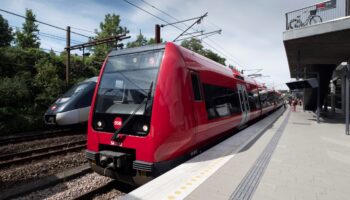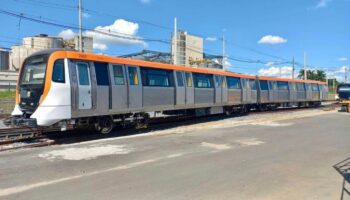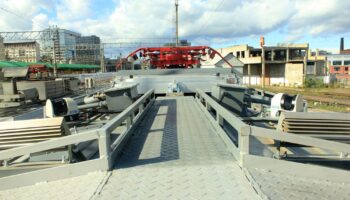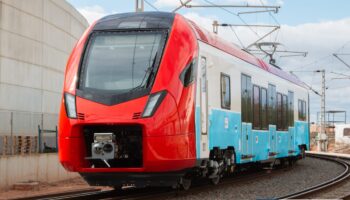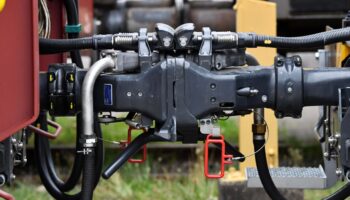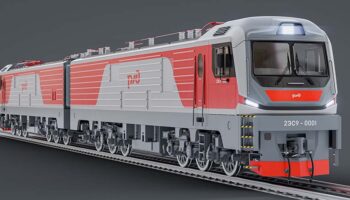The most significant events and trends in the global rolling stock market in 2023 according to the ROLLINGSTOCK team.
1. Booming demand for freight car telematics
In 2023, the global market witnessed demand for on-board sensors to monitor various parameters of freight cars online. As a result, many global players have launched paid digital services that provide such operational monitoring.
Early last year, US-based Amsted Rail received a major order to supply 7,000 IQ Series on-board telematics devices to European leasing company Ermewa. A few months later, the company signed another long-term contract for these sensors with the European subsidiary of car maker Greenbrier. In September, in response to growing demand, Amsted Rail launched an online application to track a car’s location, load, mileage, estimated time of arrival, damage and other parameters.
Demand for sensors from the largest player in the telematics market, the Swiss company Nexxiot, has been growing all year. Ermewa selected it to supply Globehopper on-board telematics devices that transmit location, mileage, car utilisation, shock loads and other data. The technology can be deployed on more than 45,000 of the company’s freight cars. US-based TTX announced its intention to equip more than 1,700 box cars and autoracks with Nexxiot sensors in 2023. At the same time, Nexxiot is one of the participants in a large-scale North American project to implement telematics on freight cars, RailPulse.
 Nexxiot GPS sensor installed on a Union Pacific freight car as part of the RailPulse project. Source: Union Pacific
Nexxiot GPS sensor installed on a Union Pacific freight car as part of the RailPulse project. Source: Union Pacific
Nexxiot’s digital offering is more functional than Amsted Rail’s. In 2023, the company introduced an analytics application that runs on telematics data from cars and containers. It can handle free-form queries because self-learning algorithms select the necessary data and present it in the form of charts, maps, etc. Nexxiot’s collaboration with Knorr-Bremse has expanded. The companies are now working on a unified technological solution for monitoring and analysing the condition of freight and passenger train components. Access to the data will be provided on a paid subscription basis.
Netherlands-based IMT said it plans to develop a telematics system for the North American freight car market. The project is being implemented in partnership with US wagon builder Wabtec. The system’s sensors will be installed on new and existing rolling stock and tank containers. Wabtec itself is developing a telematics solution for freight cars. Its sensors will monitor the condition of the braking system and car bogies as part of the French MONITOR project.
 Rendering of the mainline electric locomotive by Siemens Mobility for Indian Railways. Source: Siemens Mobility
Rendering of the mainline electric locomotive by Siemens Mobility for Indian Railways. Source: Siemens Mobility
2. Major contracts of Siemens and TMH in India
For several years now, the Indian market has been one of the world’s main points of growth in demand for rolling stock. In 2023, the trend remained the same: large contracts are being signed to ensure the development of production facilities and technology transfer under the national programme, Make in India. The only thing that has changed is the entry of global rail suppliers.
At the beginning of 2023, Siemens Mobility signed a contract with national operator Indian Railways (IR) for the supply of 1,200 mainline electric freight locomotives. According to the latest information from the manufacturer, the deal is worth €2.9 bln. The rolling stock will be assembled at the operator’s former depot in Dahod, which will be upgraded and its production capacity expanded. The first five electric locomotives are expected to be produced this year, with the full batch to be ready by 2034.
In the strict sense of the word, this is not the first time that Siemens Mobility has entered the country’s market. It has previously supplied signalling systems and components. For TMH, however, the signing of a contract with IR for the supply and maintenance of 120 Vande Bharat EMUs with sleeping cars was indeed a debut. TMH teamed up with its Indian partner Rail Vikas Nigam to bid for the contract. Their consortium, Kinet Railway Solutions, offered the lowest price, beating bids from local manufacturers as well as Siemens Mobility, Alstom and Stadler. According to TMH, the total value of the supply and 35-year maintenance, subject to indexation, is potentially $6.5 bln. The first prototype trains are expected by the end of 2025.
 Tests of the CR400AF-J and CR400BF-J trains on the cross-sea bridge over the Meizhou Bay. Source: Хinhua
Tests of the CR400AF-J and CR400BF-J trains on the cross-sea bridge over the Meizhou Bay. Source: Хinhua
3. Development of a train with a design speed of 450 km/h in China
Summer 2023 saw the national operator China Railway’s successful performance tests of components to be used in the CR450 train with an operational speed of 400 km/h and a design speed of 450 km/h. The components were installed on two test trains, the CR400AF-J and CR400BF-J, which have been undergoing trials since April 2022. The trains ran towards each other at 453 km/h over the Meizhou Bay cross-sea bridge, with a closing speed of 891 km/h. The trial runs witnessed 57 studies of running over bridges, through tunnels and on curves at different speeds. The tests assessed the performance of the components during operation and their aerodynamic and noise properties at high speed in the open and in tunnels.
CR450 EMU is to be the last model of CRRC’s Fuxing series. The trainset will feature nine new-gen solutions, tailored by China: eddy current brake, carbon ceramic brake disc, permanent magnet traction system, and pantograph active control, among others.
Previously, Zhao Hongwei, the chief engineer at the China Academy of Railway Sciences, said that the train’s basic design is to be finished in 2024. Images of the prototype being assembled were published in spring, however there was no additional information on its production in open sources. According to Hongwei, the train development faces many challenges. For example, new standards are required to adopt the higher operational speed (400 km/h instead of 350 km/h).
 The electric train of the Copenhagen urban railway. Source: The STB/flickr
The electric train of the Copenhagen urban railway. Source: The STB/flickr
4. The world’s major tender for unmanned EMUs in Denmark
In May 2023, national operator DSB announced a tender for the supply and maintenance of 226 trains with the highest level of automation, GoA4, for the Copenhagen S-bane. Alstom, CAF and a consortium of Siemens Mobility and Stadler have qualified for the competition.
The potential order, estimated to be worth €3.5 bln, will include an option for 100 trains and an extension of the maintenance period from 30 to 44 years. The required operating speed of the trains is 120–160 km/h. The operator expects the winner to be selected in spring 2025, the first trains to be tested in 2028, and the new fleet to enter service between 2029 and 2037.
It is already known that Siemens Mobility will supply the on-board CBTC system for 226 trains to control traffic. The company was awarded the contract without tender, having previously installed the system on the entire S-train network.
As the strategy and rolling stock director at DSB Jürgen Müller told pro.ing.dk, initially it was proposed to use the distributed acoustic sensing technology with sensors at the front of the train to ensure safety on the tracks. Now, the company is leaning towards doing away with platform doors, using track fencing between stations, and installing object detection systems at stations.
 Production of the Alstom Aventra cars at the Derby plant in the UK. Source: City A.M.
Production of the Alstom Aventra cars at the Derby plant in the UK. Source: City A.M.
5. Alstom’s poor financial performance after the acquisition of Bombardier Transportation
Last autumn, the company published its financial report for H1 FY23/24 (April–September 2024), in which it announced a sharp rise in negative free cash flow to -€1.1 bln, a 60.8% increase in net debt to -€3.4bn, and a 16% fall in new orders from €10 bln to €8.4 bln. Alstom chairman and CEO Henri Poupart-Lafarge said the negative performance was due to difficulties in the production of the Aventra EMUs at the Derby plant in the UK, and the integration of Bombardier Transportation assets acquired in early 2021. Alstom’s reporting shows that losses and other expenses for the period totalled €92 mln, of which €65 mln are related to the merger integration of Bombardier Transportation.
The French manufacturer unveiled a five-point plan to optimise the performance of the acquired assets. The measures are aimed to increasing the margin on the backlog, ramping up the production of rolling stock, improving on-time delivery, reducing inventory turnover, and cutting 1,500 jobs. The largest reduction is planned for the Derby plant, where 1,300 jobs will be lost due to a lack of long-term orders. In this context it should be recalled that the British Railway Industry Association reported in the summer of 2023 that it saw a risk of plant closures in the country in the absence of new orders for rolling stock.
 Manufacture of Stadler EMUs at the Bussnang plant in Switzerland. Source: Ben Jones/X
Manufacture of Stadler EMUs at the Bussnang plant in Switzerland. Source: Ben Jones/X
6. Continued trend of Stadler’s global market share growth
The Swiss manufacturer’s performance remains positive, and it is not the first time it has updated its record. Although orders and revenues for 2023 were down, the company reported a new record backlog of €25.4 bln, 16% more than in 2022 and more than one and a half times that of 2021. Last year, SCI Verkehr, a consulting company, announced that Stadler had entered the top 3 in the global rolling stock market.
Last year’s biggest order was for the delivery of 537 passenger coaches to Kazakhstan in 2025–2030 and their maintenance for 20 years. The company signed the €2.3 bln contract with the national operator Kazakhstan Temir Zholy. In March 2023, Stadler signed a contract with the Norwegian operator Norske Tog for the supply of 17 FLIRT Nordic Express long-distance trains, with an option for a further 66 trains.
Stadler has secured a number of major contracts for multiple units. Some of the most notable contracts in this segment are with the Austrian national operator OBB. One of the contracts involves the delivery of 35 KISS double-decker EMUs worth around €600 mln, and the framework agreement of 2022 covers the delivery of up to 186 such trains. In addition, OBB has ordered 16 FLIRT Akku hybrid trains powered by catenary and battery under another €1.3 bln framework agreement for 104 trains. Many Stadler’s deals were signed in the tram and locomotive segments.
 Rendering of a Comfort couchette for the Intercity Notte night service. Source: Škoda Group
Rendering of a Comfort couchette for the Intercity Notte night service. Source: Škoda Group
7. Expansion of India’s Titagarh Rail Systems in Europe
The company’s Italian division, Titagarh Firema, which specialises in the production of metro and electric trains, has entered two new market segments: passenger and freight cars. In early summer, the company signed its first contract, worth €5 mln, to supply 36 container flatcars to the local railway infrastructure maintenance company GCF. Titagarh Firema’s managing director, Carlo Logli, said the company plans to deliver around a hundred freight cars in 2024 and to expand production in 2025 with the new workshop for building 40-, 45-, 60- and 90-foot flatcars at the Caserta plant.
In August, in a consortium with Skoda Group, the company won the largest contract in its history, worth €732.5 mln, to supply up to 370 passenger coaches to the national rail operator Trenitalia. The firm part of the contract includes 70 coaches for the Intercity Notte night service for €138.6 mln. The rolling stock is scheduled to enter service by the end of June 2026.
Titagarh is a privately held company, and as part of its strategy to expand into the global market, the state investment agency Invitalia and the UAE-based Hawk Eye fund increased its equity in 2022.
 Remote control panel for testing the Lastochka EMU at the Moscow Centrtal Circle. Source: RZD/telegram
Remote control panel for testing the Lastochka EMU at the Moscow Centrtal Circle. Source: RZD/telegram
8. Testing remote control of the Lastochka EMUs on the route with other trains
At the end of March, for the first time in the world, a train operator remotely controlled two Lastochka EMUs, which were running simultaneously with other trains on the Moscow Central Circle (MCC). This network, part of the capital’s urban railway system, is run by the national operator Russian Railways. The first train, ES2G-113, is automated up to GoA3, and the second, ES2G-136, up to GoA3+. The train operator controlled them from a remote control centre.
Since 2017, the development of automated train operation on the MCC has been the responsibility of the Russian Railways research institute, NIIAS. It aims to reduce intervals between trains to three minutes and is now working to create a fully unmanned train using GoA4 technologies. Russian Railways claims that one train operator will be able to remotely control four such trains. Rolling stock with this level of automation was expected in 2022, but the work was postponed because the manufacturer, Sinara–Transport Machines, needed time to develop and start production of new trains, the ES104. The possibility of using a high level of train operation automation is also included in the design of the Russian high-speed train.
 Presentation of the XNY battery locomotive at the CRRC plant in Zhuzhou. Source: Xinhua
Presentation of the XNY battery locomotive at the CRRC plant in Zhuzhou. Source: Xinhua
9. Active release of CRRC locomotives with alternative traction
Last year, the Chinese manufacturer continued on the path it has taken in recent years to develop rolling stock with alternatives to diesel engines or hybrid traction. In November, CRRC unveiled the most powerful battery-powered shunting locomotive in its portfolio. The 1.5 MW XNY is equipped with a LiFePO4 battery and can haul trainsets weighing up to 1,200 t over up to 128 km. The vehicle was developed by order of the Chinese metallurgical company Lianyang Iron & Steel.
Another locomotive, the CHA3C1, was built for the local company Meishan Iron & Steel. The vehicle is equipped with a 380 kW MTU diesel engine and a 315 kWh lithium-titanate battery, and can operate in diesel, battery and hybrid mode.
CRRC has also built a hydrogen shunting locomotive for export to Chile. The vehicle is powered by a 400 kW hydrogen fuel cell unit and 600 kW batteries. It is said to be capable of hauling trains weighing 1,000 t over a distance of about 400 km.
Last year, CRRC for the first time converted a diesel locomotive to hydrogen. The locomotive, dubbed Ningdong, is equipped with an 800 kW hydrogen engine and has enough hydrogen for 190 hours of operation. There are now more than 7,800 diesel locomotives in China now, and, according to CRRC, the approach used in this project allows 90% of them to be converted.
The manufacturer already signs contracts for locomotives with alternative traction. For example, its German subsidiary, Vossloh RS, has received an order for up to 187 hybrid locomotives from the local leasing company, Railpool. These Modula hybrid shunters with three traction combinations were unveiled at InnoTrans–2022 a year earlier.
 The hybrid Blues train by Hitachi in Italy. Source: transportrail
The hybrid Blues train by Hitachi in Italy. Source: transportrail
10. First-ever reporting on social impact of trains by Hitachi Rail
The Japanese manufacturer declares that it will prepare Social Product Declarations (SPD) for its rolling stock. In cooperation with EPD International, a provider of corporate sustainability data, the company has developed a questionnaire and calculated the social impact of the Masaccio HMU, the HTR 412 Blues. These are now being delivered in Italy.
In calculating the ethical life cycle, Hitachi Rail considers not only the end products, but also the suppliers’ performance in terms of legal compliance, employee safety, fair salaries, and gender equality. The SPD report on the Masaccio HMU includes an assessment of raw material suppliers (steel, copper, aluminium) from 23 countries. The assessment will cover the entire 30-40 year life cycle, from design and sourcing to decommissioning and disposal. According to Hitachi Rail, the SPD mechanism will make it possible to create an automated platform for managing data from more than 20,000 suppliers.
Other events and trends
ROLLINGSTOCK’s short list included other events that, however, did not make the top 10. Here they are.
— Parallel Systems and Intramotev developing autonomous freight cars in the USA
—Skoda Group to diversify its backlog of orders: metro trains for Bulgaria, electrical multiple units for Uzbekistan, overhaul of diesel locomotives in Egypt
— Newag accused of deliberately programming train failures
— First unmanned metro train and electric locomotive from Turkiye
— USA and India start buying high-speed trains
— Wabtec, CRRC and Stadler to expand their presence in Kazakhstan
— Europe discussing the use of ammonia as alternative fuel
— Spain scandalised by CAF train design flaws
— Pesa goes global: large orders for EMUs in Romania, tram contract with Israel, and construction of DMUs for Ghana
— Europe to return to maglev
— Tougher rules for diesel locomotives adopted in the USA
— First Indian urban rail network opened
— CRRC revenue loss due to lower domestic order for high-speed trains










